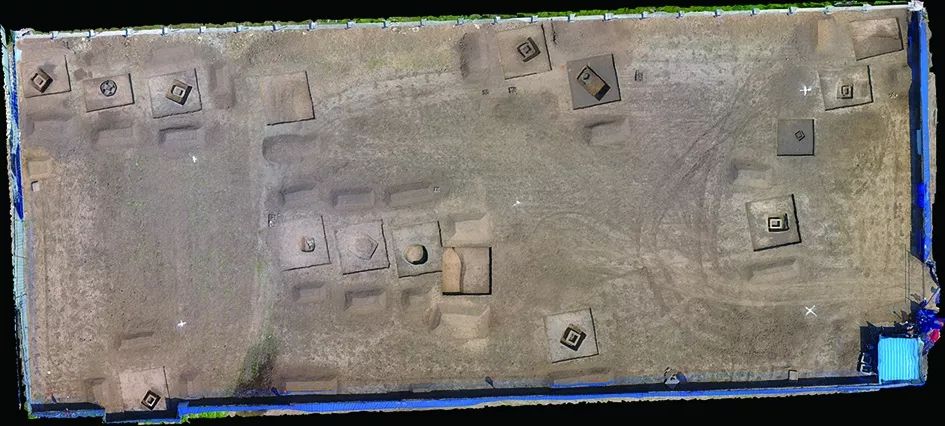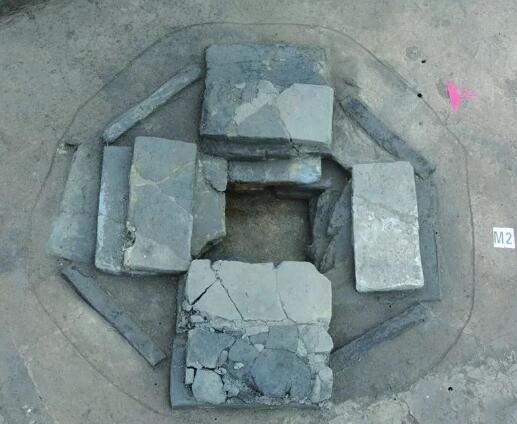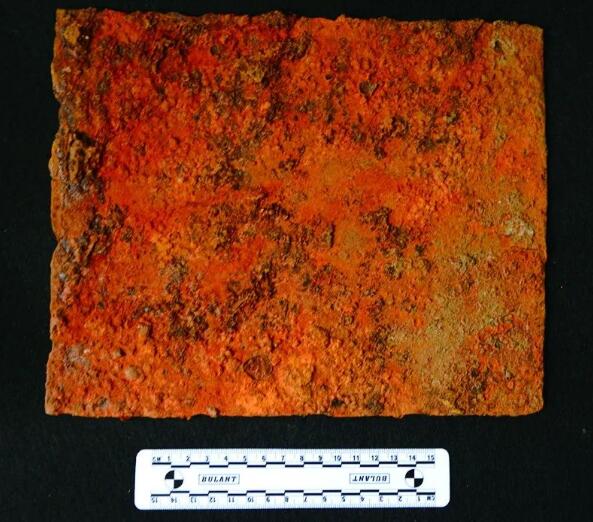Jin Dynasty tombs found in Acheng, Heilongjiang
The cemetery is located in Acheng District, Harbin City, Heilongjiang Province, about 1000m east of west wall of north city of Jinshangjing Capital. From May to July in 2018, archaeological excavation has been conducted by an archaeological team consisting of Heilongjiang Provincial Institute of Cultural Relics and Archaeology. 15 tombs have been uncovered, which can divide into two types according to tomb forms. Main achievements from this season’s excavation are as follows:

The aerial photo of the cemetery
Tombs with earthen grave and bricked coffin
7 tombs with earthen grave and bricked coffin were cleared, including 3 complete ones and 4 destroyed. They are of varied sizes and have rectangular, square or polygonal plane. The brick coffins are constructed by rectangular, gray bricks, whose openings are all beneath the surface of the soil. There are usually bone ash and residues being placed in the coffin. Burial gifts contain pottery pots, iron plaque, bronze mirror and so on. Now, M2 and M5 will be introduced briefly as examples.
M2 is well-preserved with a round tomb grave, whose diameter is about 1.25-1.3m. Bricked coffin is octagon in plane and constructed by gray bricks. The inner walls of coffin is square. The bottom of the coffin is not paved with bricks. No bone ash and residues have been found. 3 burial gifts have been unearthed, including a pottery pot, an iron plaque and a bronze mirror. The bronze mirror has flower-bird-bead pattern. There are engraved characters of “shang jing xun yuan” in the edge.
M5 is located in the north part of the excavating area with a square grave, 1.6m long for each side and 0.58m deep. The bricked coffin is rectangular in plane and constructed by rectangualr gray bricks. The ceiling has already been collapsed. In the bottom of the coffin, there are two pieces of gray-bricks being used as tomb bed with bone residues on it. No funeral goods have been discovered.

Tomb M2
Tombs with earthen grave and stone coffin
8 tombs with earthen grave and stone coffins (M1、M3、M7、M8、M9、M10、M11、M12) have been unearthed. 5 of them are complete burials and the rest have been destroyed. Here, M1, M9 and M12 will be introduced as follows.
M1 is situated in northwest corner of excavated area of the cemetery. There is a stone coffin in the center. The coffin is cuboid with a cover. Inside the coffin, there is a rectangular box. Traces of wooden box could be recognized within the stone box. Bone ash and residues were placed in it without any burial goods.
M9 is located in southeast corner of the excavated area. There is a cuboid stone coffin in the center, with a cover on it. Inside the coffin, there is a rectangular box with bone ash and residue within it. 6 pieces of irregular, little stones are placed in the edges of the bottom of stone coffin.

The stone box

The iron tablet
M12 is situated in northwest part of the excavating area with a stone box in the center. Inside the stone box, trace of wooden box could be recognized. Bone ash and residues were found in it.
This area should be a cemetery area outside the city of Jin shang jing Capital, discovering plenty of burials with distinct characteristics and important academic values. According to tomb forms, earthen-pit tombs with stone coffin is an important, widely-distributed burial form for cremation in Jin Dynasty. Tombs with bricked coffin uncovered from this excavation have special form and relatively small tomb coffin, all for cremation. Their funeral practice is the same with that of the bricked coffin tombs. Relatively small artifacts have been found from the tomb chamber. Based on the characteristics of several pottery, iron plaque and bronze mirror, it’s predicted that the date of the tomb is in middle-late period of Jin Dynasty. Tombs were arranged in lines following certain pattern, which might reflect certain kinship or relationship.(Translator:Ma Huanhuan)

